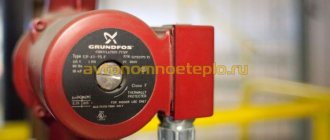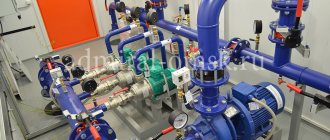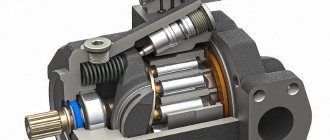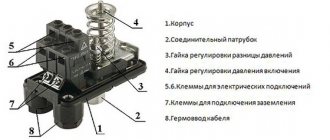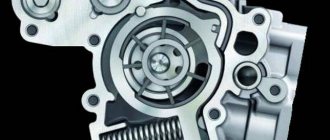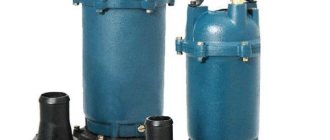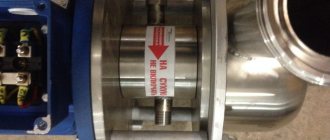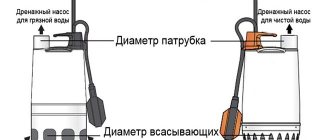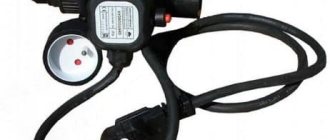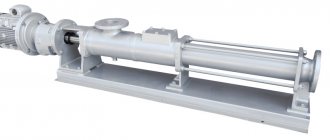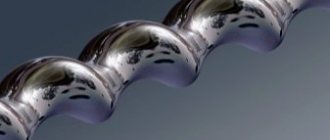Home / DHW
Back
Published: December 13, 2019
Reading time: 4 min
0
2679
In rooms with a long hot water supply pipeline, circulation pumps are used. They are installed in a separate circuit.
The DHW circulation pump makes it possible for water to flow at the required temperature immediately after opening the tap.
- 1 Design 1.1 Glanded rotor pump
- 1.2 With wet rotor
- 4.1 First launch
Design
The recirculation pump does not have much power and performance. The device pumps coolant over short distances.
Injecting high pressure from the circulation pump for DHW is not required. The product consists of a housing, an impeller and an electric motor. Under the influence of a magnetic field, when voltage is applied to the motor windings, its armature begins to rotate.
The impeller displaces a mass of water and pumps it into the outlet pipe. Liquid is drawn from the inlet pipe. When selecting a circulation pump, it is necessary to take into account its type and technical characteristics. Regardless of the manufacturer, all recirculation pumps are divided into 2 types - with a wet or dry rotor.
Dry rotor pump
In devices of this type, the water medium is located separately from the parts of the electric motor. The motor is air cooled.
Dry rotor device
A distinctive feature of units with a dry rotor is their high efficiency. Rotating parts of an electric motor require periodic lubrication. This is necessary to reduce the degree of friction between components.
With wet rotor
It’s just that this type of impeller and the armature of the electric motor are completely immersed in a water environment. Units with a wet rotor have a low efficiency.
The advantage of devices of this type is that there is no need to lubricate the rotating parts of the electric motor. Cooling of parts is carried out with water.
Wet rotor. Photo source: fl.ru
Recirculation pumps with a wet rotor are characterized by low noise levels during operation. This allows them to be used in residential areas, both during the day and at night. Often such devices are used in apartments and houses.
Selecting a pump by model popularity
It should be recognized that design differences and expected operational characteristics will “help” only a pressure equipment specialist to select a pump. But they will simply confuse the average consumer. Therefore, for non-specialists, the best selection criterion is rather the popularity of the model, which will be “more understandable” than any technical specification.
And from our point of view, buyers of pumps for hot water supply systems should pay attention to the following models of circulation units:
Domestic hot water pumps UP Grundfos series
Circulation pump for hot water UP Grundfos series
This series belongs to the “wet” type of pumps. Therefore, UP Grundfos operate absolutely silently, but with low productivity. In addition, pumps from this series have only one speed. As a result, UP Grundfos should only be purchased by owners of domestic heating systems assembled not in the boiler room, but directly in the house.
The advantages of the UP Grundfos series include the absence of the need for maintenance and the minimal risk of lime deposits forming on the inner wall of the pressure unit. Grundfos has also provided the possibility of dismantling the unit without disassembling the pipeline.
That is, we have before us an almost ideal household model of a circulation pump, with many advantages.
Circulation pump Wilo-Star-Z
Circulation pump Wilo-Star-Z
Another “wet” unit, designed to maintain pressure in both heating networks and water supply systems (both hot and drinking). Moreover, this Wilo-Star-Z model is equipped with both mechanical shut-off valves (check valve at the outlet and ball valve at the inlet) and electronic components (timer, thermostat, display, etc.).
As a result, the Wilo-Star-Z model can be used both in conventional heating systems and in high-tech heating networks integrated into the “smart home” system. This pump also has a recognition system for the thermal disinfection function used when working with drinking water.
Pump VortexBW 152 R1/2″ oT
Circulation pump VortexBW 152 R1-2″ oT
This pump is produced by the German company Vortex. Moreover, the pragmatic Germans, who simply do not know how to make bad equipment, endowed the model with not only noticeable performance, but also amazing maintainability. The pump can be disassembled without much hassle and without the need to dismantle the unit itself. Therefore, the VortexBW 152 R1/2″ oT model can be descaled without removing it from the pipe.
In addition, 152 R1/2″ oT operates absolutely silently and differs from similar competitors’ products in its very modest dimensions . Therefore, this model is simply irreplaceable in everyday life.
Pump ESPA RA1-S 25-60
Circulation pump ESPA RA1-S 25-60
The ESPA RA1-S 25-60 pump is another “wet” type unit designed for ventilation and air conditioning systems. The main difference between this model and similar proposals lies in the possibility of vertical installation. Moreover, ESPA RA1-S 25-60 can be used in both hot water supply systems and cold water supply lines.
However, this pump cannot pump flammable liquids and water heated to a temperature of 120 degrees Celsius. But in domestic heating networks, this model has proven itself as an economical and productive pump, with which you can solve any problem.
Operating principle
Circulation pumps are used to constantly move liquid in a hot water system. To connect them, it is necessary to install a storage tank. Liquid is drawn through the inlet pipe of the pump, which creates a vacuum and water from the storage tank enters the circuit.
The pump impeller pumps the liquid, building up pressure in the outlet pipe, while at the same time the cooled water flows back into the container. Thus, with constant operation of the pump, there is a continuous circulation of coolant in the system.
The principle of operation of the pump in the diagram
The hot water supply circuit does not end at the extreme point of water intake, but is connected to a storage tank. Thus, the liquid constantly circulates in the system, regardless of whether the water intake points are open or closed. For ease of use, a shut-off device can be installed on the return flow pipeline. This will shut off the circuit and stop recirculating the hot water supply if necessary.
How does a circulation pump work in a hot water supply system?
The operating principle of the DHW circulation pump is almost identical to that used in heating systems. The purpose of the installation is to increase and stabilize the missing water supply pressure.
Circulation pumps in domestic hot water systems of private residential buildings operate as follows:
- A closed hot water system is installed, consisting of: a storage tank, shut-off and control valves, pumping equipment and a circuit connected to water distribution points.
- Hot water is drawn into the container. The pump creates the necessary pressure, forcing a certain amount of water to constantly circulate in the pipeline circuit.
- When the tap is opened, the consumer immediately receives hot water under pressure, sufficient to take a shower, quickly draw a bath, etc.
Most models of pumping equipment designed for hot water supply have electric motors based on a “wet rotor”. All moving parts are completely immersed in water. The “wet” design has many advantages: no need for maintenance, quiet operation, low energy costs.
Along with this, there is a danger of dry running. The coolant plays the role of a lubricant. Without lubrication, bearings instantly fail.
How to choose a pump for hot water supply
When choosing a pump, it is necessary to take into account the technical characteristics of a particular model. This will allow you to purchase a recirculation pump with parameters suitable for a specific hot water supply system.
When choosing, the following are taken into account:
- noise level. Depending on the model, the noise level may vary. For a living space, it is better to choose a quiet pump;
- pressure of the supplied liquid. It is measured by the maximum height of the water column. If the DHW circuit is located in the same horizontal plane as the pump, models with a column height of 50 - 80 cm are suitable. For tall buildings and structures, this parameter must be taken into account with a reserve;
- electricity consumption. Depending on the pump model, its power ratings may vary.
Main characteristics
When choosing a circulation pump for domestic hot water or heating, you should pay attention to the following characteristics:
- productivity – the amount of liquid that a recirculation electric pump is capable of pumping per unit of time (m3/hour or liter/min);
- pressure or pressure of the liquid medium created by the pump (meters of water column or Pa);
- power consumed by the recirculation pump (W);
- method of controlling the device (using a timer or temperature sensor).
Since recirculation pumps pump small volumes of liquid, which moves in heating pipes or water pipes at low speed, such devices do not require high power and performance. Thus, to maintain the water temperature in domestic heating and water consumption systems, the length of which does not exceed 40–50 meters, a recirculation pump with a capacity of 0.2–0.6 m3/hour will be quite sufficient.
Grundfos pump with a capacity of 3.3 cubic meters. m/hour
In terms of electricity consumption, boiler and hot water pumps are also economical, since their power, depending on the model, ranges from 5 to 20 W. This is quite enough for the electric water pump to be able to ensure efficient circulation through the hot water pipes in a private house.
It is very important to choose the right circulation pump according to such a parameter as the pressure of the liquid flow that it is capable of creating.
To choose the right pump according to this characteristic, you can follow the following recommendations when selecting recirculation equipment for heating and hot water systems of both a small residential building and a large cottage with several floors.
- If the pipes through which the pump must circulate the liquid medium are located at the same level, then we select equipment with a pressure value of 0.5–0.8 meters of water column.
- If the house has several floors, DHW recirculation must be ensured at several levels of the pipeline, which means that the height to which the liquid must be raised must be taken into account.
In order to make recirculation of the liquid medium more efficient in heating and hot water systems, pumps should be selected with a certain reserve in the pressure generated.
How to connect
To properly connect the pump to the hot water supply circuit, you must strictly follow the operating instructions provided by the manufacturer. If there are protection systems provided by the manufacturer, their installation is mandatory.
Connection is carried out in the following sequence:
- Selection of installation location. It is better to mount the pump in a separate pocket. This installation method will allow you to exclude it from the system if necessary. This may be needed for preventative measures or repairs.
- Stopping the water supply and draining the liquid from the circuit. Carrying out work if there is water in the system is prohibited. This may lead to flooding of the room.
- Removing part of the pipeline. Cutting metal pipes is carried out with an angle grinder or other tools. For plastic pipelines, specialized scissors are used. They make an even cut, which has a positive effect on the quality of soldering.
Connection. Photo source: bakilux.com.ua - Installation of threaded connections and pump installation.
- Connection to a household electrical network. The device must be connected to the electrical network in strict accordance with the operating instructions.
- Start-up and commissioning of the unit.
First start
Before turning on the pump, it is necessary to exclude the presence of air in the system. To do this, water pressure is pumped into the supply pipe until liquid flows from the return pipe. Starting the pump without water in the system is not recommended. This can lead to rapid failure of the device.
How to calculate hydraulic resistance?
To avoid counting by hand, use our calculator.
It has already been said that the selection of a circulation pump for a heating system is directly influenced by such an important parameter as hydraulic resistance, which is created by individual elements of the heating system, allows you to calculate the suction height of the pump and, as a result, makes it possible to select a model of equipment based on power and the pressure created. To calculate the pump suction (denoted by the letter H), use the following formula:
H = 1.3 x (R1L1 + R2L2 + Z1……..Zn) / 10000
The parameters used in this formula are listed in the table.
| Designation | Parameter | Unit |
| R1, R2 | Pressure loss created by the circulation pump in the supply line of the pipeline and in the return line | Pa/m |
| L1, L2 | Length of the supply and return pipelines | m |
| Z1…Zn | Hydraulic resistance created by individual elements of the heating system | Pa |
The values of R1 and R2 that are used in this table should be selected using a special information table.
The values of hydraulic resistance that are created by various devices used to equip heating systems are usually prescribed in the technical documentation for them. If such information is not available in the device passport, then you can take approximate readings of the hydraulic resistance (see table).
| Heating device | Hydraulic resistance, Pa |
| Boiler | 1000–2000 |
| Plumbing mixer | 2000–4000 |
| Thermal valve | 5000–10000 |
| Device for determining the amount of heat | 1000–1500 |
There are special information tables that allow you to find out the hydraulic resistance for almost any element of heating system equipment.
Knowing the suction height, for the calculation of which the above formula is used, you can quickly select a circulation pump based on its power and find out its required pressure.
Pump control
24-hour circulation of water in the system is economically unprofitable. Depending on the control method, there are 2 types of recirculation pumps:
- Controlled by the control unit based on the temperature sensor readings. Water is recirculated in the system as it cools. The sensor is mounted in the hot water circulation circuit. When the fluid temperature is within the specified limits, the motor rotor and the impeller pumping the fluid stop. As the indicator drops, the pump automatically turns off. This allows you to constantly maintain the temperature of the liquid in the desired range.
The pump is controlled by a controller, depending on the outside temperature - Timer controlled. The DHW recirculation pump automatically turns on and off after a certain period of time. The time interval between alarms is set by the user. In this case, it is necessary to calculate the length of the circuit, the speed of fluid movement and the presence of heat loss. Depending on the model, you can program the device for 24 hours or 7 days.
Purpose and scope
Hot water recirculation pumps have a very important function. With the help of such devices, closed pipelines through which hot water is transported operate in the required mode. By pumping liquid into the pipeline due to the rotation of special elements, recirculation electric pumps increase the pressure of the liquid medium they pump and, accordingly, the speed of its movement.
Most often, heating systems are equipped with recirculation pumps, which increases not only the efficiency, but also the cost-effectiveness of the latter. Most of these systems, as is known, operate using a coolant, which, moving through a pipeline, releases heat into the room. Heating of the coolant (in this case, before it is supplied to the pipeline) is provided by a boiler, boiler or water heater. After passing through the entire heating circuit, the water must return to the heating equipment, where it is again given the required temperature.
DHW recirculation scheme
Without the use of special pumping equipment, water circulation in the heating system will flow slowly, and in some cases may not flow at all, since the pressure of the coolant flow, which is not further increased in any way, will be dampened by the pipeline elements. The result of this is unevenly heated heating pipes and, accordingly, an uncomfortable temperature in the premises of the house.
A circulation pump for hot water supply increases the pressure and pressure of hot liquid moving through a closed pipeline circuit. The use of circulation pumps for hot water is especially important in the pipeline systems of houses with an area of more than 200 m2, in which there are several water intake points, and the boiler is installed in a separate room or in the basement. Water in such pipelines (as a rule, quite long), if they do not have a recirculation system using a special pump, cools down quite quickly. This leads to the fact that when you open the tap you have to wait a long time until liquid heated to the required temperature flows out of it.
In addition, when some taps at water intake points are opened immediately, the water pressure in them drops, because the pressure of the liquid moving through the pipeline by gravity is not additionally supported by anything. To solve precisely these problems faced by owners of private and apartment buildings, a hot water pump is designed to provide forced movement, as well as the creation of stable water pressure and pressure in the hot water supply system.
The recirculation pump should not be installed near tanks or water heaters, the heat from which could affect the thermostat.
Using a circulation pump for heating and hot water supply to a private home, in addition to the above advantages, allows you to save on energy costs. Since in systems with recirculation, water from the boiler is transported through pipes forcibly and reaches all water intake points and heating radiators much faster, its temperature during such transportation decreases slightly. A boiler, if forced water recirculation is provided in the pipeline it serves, requires less time to heat it, and accordingly, the consumption of energy carriers used to operate the heating equipment is reduced.
Pumps for circulating hot water are actively used to equip “warm floor” systems, the design of which assumes the presence of an extended pipeline circuit of a complex configuration, consisting of small-diameter pipes. In such cases, the circulation pump ensures constant movement of the coolant through the pipes.
The circulation pump is a mandatory element of the underfloor heating system
Which pump is better Grundfos or Wilo
Grundfos DHW pumps and similar products from Wilo are high-quality pumps for hot water recirculation from European manufacturers. Grundfos pumps, like Wilo devices, have their advantages and disadvantages. When choosing, you must rely on the technical characteristics of certain models.
Regardless of the manufacturer, the pump must fit the operating parameters. Violating this rule will shorten the life of the product. Hot water circulation pumps are used to ensure uninterrupted supply of liquid regardless of the length of the pipeline. Product specifications vary depending on the model. This must be taken into account when choosing a device
Features of recirculation pump control
A time relay is used to control the operation of the recirculation pump, since the unit is not used for continuous operation, but only to maintain the required water temperature. In practice, for a well-ventilated pipeline this time period is 20–25 minutes. Most modern pumps are already equipped with a time relay and temperature sensor. In such devices, the time interval between turning the pump on and off is set in the program using the controller.
Correct adjustment of the device can reduce energy consumption of the equipment by at least 50%. To further reduce energy costs, some models are equipped with an automatic control system that adapts to the specific water needs of residents. For example, after installing a pump, the system tracks the time residents use water for 1-2 weeks. After this, the device’s automation receives data that allows it to adapt to certain operating conditions.
Installation diagrams
Depending on the number of connection points and the length of the pipes, the method of connecting the circulation pump and pipe routing is selected:
- serial connection with one circuit;
- parallel connection with the collector.
In the first case, all water intake points are connected in series and in one circuit. This is beneficial if you can easily combine the bathrooms and kitchen with one water pipe without unnecessary material costs and a fairly short route. There is only one feature that concerns the pressure pump rather than the circulation pump. If several water intake points are open at the same time, the pressure in each of them will be divided equally. Alternatively, this can be solved by installing a gearbox on each tap and choosing a more powerful pump.
The simplest installation diagram for a recirculation pump
Parallel connection solves the problem with pressure and water distribution using a manifold group and compact placement of gearboxes. In this case, recirculation pumps must be installed in each individual circuit or one more efficient pump must be selected for all groups at once. Such wiring is necessary if there are several bathrooms in the house, spaced far from each other and from the kitchen, or when, with a serial connection, the total length of the route becomes too long.
